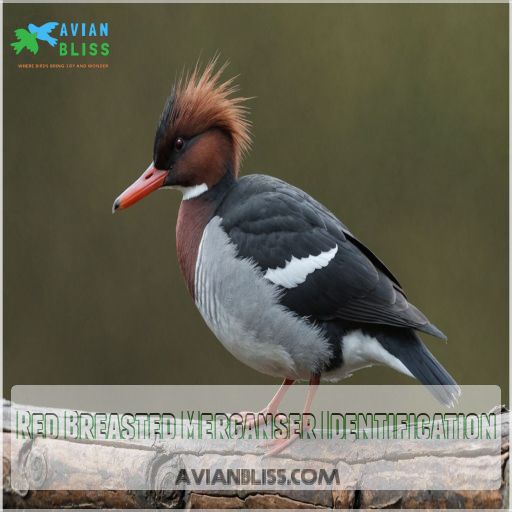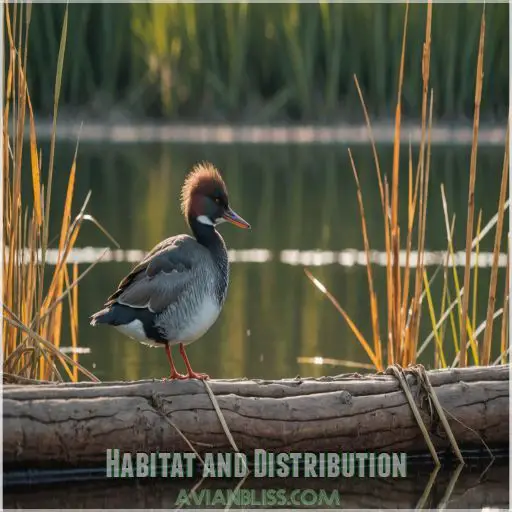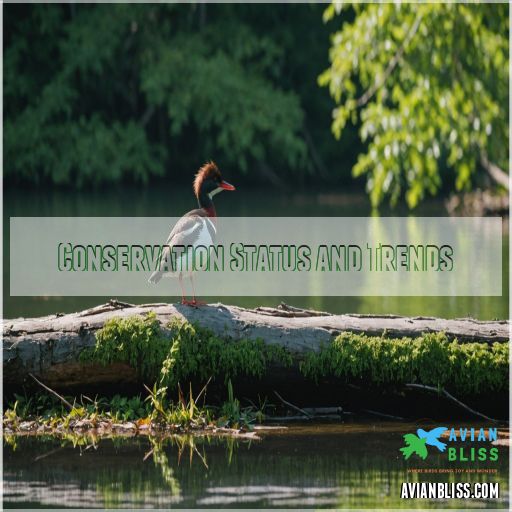This site is supported by our readers. We may earn a commission, at no cost to you, if you purchase through links.

Males flaunt a vibrant green head and rusty chest, while females rock a more subtle brown look. They’re coastal cruisers in winter but head inland to breed, nesting near lakes and rivers.
Watch for their cooperative hunting – they’ll form a fish-herding flash mob to corral their dinner. These high-speed flyers can hit a whopping 81 mph, making them the Usain Bolt of the duck world.
Table Of Contents
- Key Takeaways
- Red Breasted Merganser Identification
- Habitat and Distribution
- Behavior and Social Structure
- Diet and Foraging
- Nesting and Reproduction
- Similar Species and Confusion
- Conservation Status and Trends
- Frequently Asked Questions (FAQs)
- Are Red-breasted Merganser rare?
- Are Red-breasted Merganser good to eat?
- What is the difference between a Common Merganser and a Red-breasted Merganser?
- Where is the best place to hunt Red-breasted Merganser?
- How long do red-breasted mergansers typically live?
- What predators pose threats to red-breasted mergansers?
- Do red-breasted mergansers have any unique courtship rituals?
- How do climate changes affect red-breasted merganser populations?
- Can red-breasted mergansers hybridize with other duck species?
- Conclusion
Key Takeaways
- You’ll spot a red-breasted merganser by its shaggy "punk rock" hairdo and thin, serrated bill. These underwater acrobats can dive up to 20 feet deep to catch fish, making them nature’s high-speed fishing specialists.
- Don’t be fooled by their cousins: red-breasted mergansers are slimmer than common mergansers, with spikier crests and cinnamon-colored chests on males. They’re coastal cruisers in winter but head inland to breed, nesting near lakes and rivers.
- These feathered frequent flyers are masters of adaptation, equally at home in fresh or saltwater. They’ll form fish-herding flash mobs to corral their dinner, showcasing their cooperative hunting skills and environmental flexibility.
- While they’re not rare, red-breasted mergansers face challenges from habitat loss and climate change. You can help by supporting conservation efforts and keeping an eye out for these speedy swimmers – they might just zoom by at a whopping 81 mph!
Red Breasted Merganser Identification
To spot a Red-breasted Merganser, look for their slim, crested silhouette, paired with a striking mix of colors like gray and red.
Males boast a flashy white collar and reddish breast, while females are a bit more understated with their gray bodies and orange-brown heads.
Visual Distinctions
In bird identification, differentiating a red-breasted merganser can be a walk in the park once you know the tricks!
- Male vs. Female: Males have vibrant green heads, while females sport a subtler brown shade.
- Head Shape & Bill Size: Notice the thin, serrated bill and shaggy double crest.
- Color Variations: Distinct rusty chest adds flair to their elegance.
Size and Shape
Spotting a Red-breasted Merganser feels like meeting an avian rock star.
It measures about two feet with a wingspan that’s sure to impress.
Look for the slightly upturned bill length, distinct head shape, and a tail length that balances its unique body proportions.
You’ll see its charisma reflected even in the way it holds its upper flanks.
Color Patterns
After considering size and shape, let’s explore color patterns. The red-breasted merganser males sport dark green heads and striking gray sides, with a dark red breast that screams "notice me!" . Importantly, common mergansers also feature dark green heads, but the key distinction lies in the body coloration and crest length.
Mergansers, like their common counterparts, use their long, serrated bills for catching fish, a trait essential for their aquatic diet common merganser characteristics.
Meanwhile, females wear subtler tones with browns and a less flashy appearance. Chicks, though, are more of a guessing game, blending in with their surroundings. Spot them if you can!
Distinctive Features
You’ve admired the color patterns; now notice that sucker for style, the Red-breasted Merganser.
With its serrated bill and scruffy crest, this bird screams rock star of the waterfowl world.
The males sport green heads and ragged crests, while females flaunt a rusty orange look.
Keep an eye on those wild hairdos and quirky neck dances!
Sexing and Aging
Distinguishing male and female red-breasted mergansers is a breeze once you know what to look for. Males have striking black and white plumage, while females sport a more subdued brown and grey look. Juvenile birds resemble females but have a paler, more mottled appearance.
With these simple tips, you’ll be sexing and aging these dapper ducks in no time!
- Males have black heads, white collars, and reddish-brown chests.
- Females have brown heads and grey bodies.
- Juveniles have a mottled brown and grey appearance.
Comparisons With Similar Species
A feathered jigsaw puzzle awaits you in North America’s waters.
Red-breasted mergansers can be tricky to spot among their lookalikes. They’re slimmer than common mergansers, with spiky ‘dos and cinnamon chests.
Hooded mergansers sport flashier crests, while mallards lack the sleek profile. Don’t let goosanders throw you off – they’re the European doppelgangers.
Keep your eyes peeled in feeding areas and dense cover for these fish-chasing acrobats!
Habitat and Distribution
You’ll find red-breasted mergansers globe-trotting from Alaska to Europe, nesting in northern forests and tundra during summer.
Come winter, these feathered frequent flyers swap their inland digs for coastal hangouts.
They’re as comfy in saltwater as they’re in fresh, proving they’re adapted to both environments, particularly in coastal hangouts.
Geographic Range
Picture a globe-trotting duck with a taste for adventure. That’s the red-breasted merganser, found across the northern hemisphere. These feathered travelers are the ultimate snowbirds, breeding in boreal forests and tundra, then jetting south for winter.
They’re not picky, as long as there’s plenty of fish on the menu! Like the red-breasted finches with their vibrant chests, the red-breasted merganser’s striking appearance makes it a standout among fellow waterfowl, featuring a distinctive red head and orange beak.
The red-breasted merganser shares some similarities with the Rose-Breasted Grosbeak regarding its striking red plumage birds with red chests.
You’ll spot them on coastal waters, large lakes, and even fast-flowing rivers.
Breeding Grounds
During breeding season, Red-breasted Mergansers seek out boreal forest wetlands, often close to the coast (Source). These savvy birds aren’t picky, happily setting up shop in fresh, brackish, or saltwater habitats.
Their nesting strategy is a real cliffhanger:
- Ground-level nests under dense cover
- Proximity to water for easy fishing
- Solo or colony living, sometimes with gulls and terns
- Down-feather insulation for egg protection
Habitat selection is important for nesting success and brood survival, as these "serrated" bill beauties navigate predator threats and nest site competition.
Wintering Grounds
You’ll find Red-breasted Mergansers splashing about in coastal waters come winter.
These fish-loving ducks trade their northern breeding grounds for saltier digs, adapting to life in estuaries and bays.
They’re easy to spot, diving for food with their serrated bills in shallow marine waters, particularly in areas with shallow marine waters.
While some brave souls winter on ice-free reservoirs, most stick to the coast where predator threats are fewer and fish are plentiful.
Migration Patterns
Soaring across vast distances, red-breasted mergansers set out on their biannual migration journey.
You’ll find these feathered adventurers taking to the skies in late spring and early fall. They’re not early birds or nocturnal bird vision exclusively – they mix it up
!
Coastal flights happen during daylight, while inland treks occur under starry skies.
These savvy travelers follow specific flyways, adapting their routes based on weather patterns and food availability to guarantee migration success.
Coastal Vs Freshwater Environments
Red-breasted Mergansers are the chameleons of the duck world, adapting to both salty and fresh waters.
While they’re coastal connoisseurs in winter, you’ll find them splashing about in boreal forest wetlands during breeding season. These feathered frequent flyers have a knack for saltwater, often hanging out in estuaries and bays more than their Common Merganser cousins.
Talk about habitat adaptations! Their coastal nesting habits and freshwater foraging skills showcase their environmental flexibility, as they’re truly feathered frequent flyers.
Behavior and Social Structure
You’ll be amazed by the red-breasted merganser’s fascinating social life.
These ducks are true masters of air and sea, showcasing their impressive physical abilities through various feats.
From their underwater acrobatics to their lightning-fast flight.
Mating and Courtship
As breeding season approaches, these ducks put on quite a show!
The male’s courtship ritual is like an underwater dance class gone wrong.
Here’s what you might see:
- The salute: He stretches his neck up straight, looking proud as a peacock
- The curtsy: Suddenly, he dips his chest into the water, tail up
- The splash: He might kick up some water for extra flair
- The jab: If she’s impressed, she’ll give him a playful peck
Social Interactions
These feathered friends are social butterflies year-round, never defending territories. You’ll often spot them in flocks, showcasing their "birds of a feather" mentality.
During courtship, males put on quite a show with head-bobbing dances and underwater acrobatics. It’s like a hilarious aquatic ballet.
While they don’t have a strict pecking order, their cooperative foraging is a sight to behold. Who knew ducks could be such team players?
Foraging Strategies
Talk about a smorgasbord of strategies! You’ll find red-breasted mergansers employing a variety of clever tactics to snag their next meal.
They’re masters of cooperative hunting, herding fish like underwater cowboys. During winter foraging, they’ll adapt to whatever works best – from solo dives to group efforts.
Their prey selection is diverse, but fish are the main course on this duck’s menu. It’s like they’re nature’s own all-you-can-eat buffet! They’re masters of adapting to their environment in order to find their next meal.
Diving and Swimming Abilities
You’d be amazed at how Red-breasted Mergansers transform underwater!
These aquatic acrobats use their webbed feet as powerful propellers, utilizing their wing-like flippers and other efficient swimming mechanisms to reach depths of 10-20 feet
.
Their sleek bodies slice through water like torpedoes, chasing fish at breakneck speeds. Wings tucked tight, they steer with precision, snatching prey in serrated bills.
It’s like watching Olympic swimmers, but with feathers! Their underwater ballet is a clear example of nature’s ingenious adaptations and showcases their ability to perform an underwater ballet, utilizing specialized beak functions bird beak types
.
Flight Patterns and Speed
Rocketing through the sky, Red-breasted Mergansers are the speed demons of the duck world.
You’ll be amazed to learn they can clock in at a whopping 81 miles per hour.
These feathered rockets need a running start to get airborne, thanks to their rear-positioned legs.
With a wingspan built for velocity, they’re the Formula 1 cars of migration routes.
Just don’t blink, or you’ll miss their takeoff technique!
Diet and Foraging
You’ll find red-breasted mergansers chasing fish underwater with their keen eyes and serrated bills.
These adaptable divers aren’t picky eaters, snatching up crustaceans, insects, and even the occasional frog when fish are scarce.
Primary Food Sources
While Red-breasted Mergansers are social butterflies, they’re also quite the foodies.
These aquatic gourmets have a taste for the sea’s finest offerings.
Fish are their main course, typically 4-6 inches long – think of them as nature’s sushi lovers.
But they’re not picky eaters; crustaceans, insects, tadpoles, and worms are also on the menu.
It’s like they’re running an underwater buffet, catering to their diverse palate year-round.
Foraging Techniques
Red-breasted Mergansers are the underwater ninjas of the bird world.
They’ll snorkel with their eyes just below the surface, scanning for fishy snacks. When they spot a tasty morsel, they’ll plunge into action, using their webbed feet to chase down prey.
These birds are no slouches – they’ll dive up to 30 feet deep to catch their dinner.
It’s like watching a feathered submarine in action!
Hunting Cooperatively
You’ve got to see these ducks in action! Red-breasted mergansers are the ultimate team players during feeding time. They’ll form a fishy flash mob, lining up like synchronized swimmers to herd schools of fish into the shallows. It’s like watching a well-oiled machine, with each duck playing its part in the underwater roundup.
- Fish-herding formation: Ducks line up to corral prey
- Shallow water trap: Driving fish into easy-to-catch areas
- Tag-team diving: Taking turns to keep fish confused
- Share the spoils: Teamwork makes the dream work!
Adaptability in Different Environments
These savvy swimmers don’t just team up to hunt – they’re masters of adaptation too! You’ll find Red-breasted Mergansers equally at home in fresh or saltwater, shifting their foraging strategies to match the environment.
In summer, they’ll snorkel through shallow, plant-filled waters for fish and insects.
Come winter, they’re coastal crusaders, diving in marine shallows for slippery prey. Talk about flexible foodies!
Seasonal Variations in Diet
Like a culinary chameleon, the Red-breasted Merganser adapts its menu to the seasons.
In summer, you’ll find these diving ducks feasting on a smorgasbord of fish in shallow, veggie-rich waters.
Come winter, they’re coastal gourmets, diving for marine delicacies.
Their diet shifts with prey availability, from minnows to crustaceans. It’s like they’re on a year-round seafood tour, sampling the best each season has to offer with a smorgasbord of fish in shallow waters, making them culinary chameleon.
Nesting and Reproduction
You’ll find red-breasted mergansers nesting in simple depressions near water, often hidden by vegetation or tucked away in hollow stumps.
These clever ducks have a unique approach to parenthood, with females sometimes laying eggs in each other’s nests or even in the nests of other duck species.
Nesting Sites and Materials
Red-breasted Mergansers are crafty homebodies in terms of nesting. They’re all about location, location, location! These savvy ducks prefer to set up shop near water, often on coastal islands or along forested riverbanks.
When building their nests, they’re not afraid to get their feathers dirty. Here’s their DIY nest-building checklist:
- Find a cozy spot on the ground
- Gather dead grasses for insulation
- Shape a shallow bowl
- Line with soft down feathers
Egg Laying and Incubation
Once the nest’s ready, it’s time for the egg-laying extravaganza! You’ll be amazed at how these feathered moms can lay up to 24 eggs in a single clutch. Talk about a full house!
But here’s the kicker: sometimes these ladies get a bit cheeky and drop their eggs in each other’s nests. It’s like a duck version of musical chairs!
| Nesting Fact | Details |
|---|---|
| Clutch Size | 3-24 eggs |
| Egg Color | Olive-buff |
| Incubation Period | 28-35 days |
| Incubator | Female only |
Brooding and Parenting
After the eggs hatch, you’ll witness a heartwarming scene. Within 24 hours, mama merganser leads her downy ducklings to water, where they’ll learn to fend for themselves.
It’s like a crash course in "Duckling 101"! The chicks are born ready for action, with open eyes and a coat of fluffy down.
Sometimes, multiple broods join forces, creating a duckling daycare supervised by one or more adult females.
Mated Pairs and Breeding Season
During the breeding season, you’ll find these feathered lovebirds engaging in quite the spectacle. Red-breasted Mergansers put on a show with their mating rituals, featuring elaborate courtship displays that’ll make you chuckle.
Here’s what you might witness:
- Males stretching their necks forward, then suddenly dipping underwater
- Females selecting prime real estate for nesting, often near water
- Couples forming strong bonds, with males sticking around during incubation
These rituals are nature’s way of ensuring breeding success and parental care.
Nesting Success and Failure
Red-breasted Mergansers face a rollercoaster ride when it comes to nesting success. You’d think these feathered fish-finders would have it easy, but life’s no picnic on the shoreline.
Let’s take a peek at the factors that can make or break a merganser family:
| Factor | Impact | Mitigation |
|---|---|---|
| Predator impact | High | Dense cover |
| Nest site selection | Important | Near water, sheltered |
| Human disturbance | Moderate | Remote locations |
| Brood parasitism | Occasional | Vigilant females |
| Egg viability | Variable | Proper incubation |
Remember, it’s not all doom and gloom – these plucky ducks are masters of adaptation!
Similar Species and Confusion
You might mistake a Red-breasted Merganser for its look-alike cousins, like the Common Merganser or Hooded Merganser, if you’re not paying attention.
Let’s explore the key features that’ll help you spot the differences and avoid a case of mistaken duck identity.
Common Merganser
From a distance, you might mistake a Common Merganser for its red-breasted cousin. They’re like two peas in a pod, but with a few key differences. You’ll spot the Common Merganser by its larger size and distinctive white body on males.
Here’s what to look out for:
- Males sport a dark green head and orange-red bill
- Females rock a cinnamon-colored head with a shaggy crest
- Both sexes have a white wing patch in flight
Mallard
You might think a Mallard’s a piece of cake to spot, but don’t be fooled! These dabblers can throw you for a loop with their varied plumage.
Males sport that iconic green head, but females and juveniles? They’re masters of disguise.
Watch for the telltale blue speculum and orange feet to crack the case.
Unlike our diving merganser pals, Mallards prefer to tip up in shallow waters, gobbling up plants and insects.
Hooded Merganser
While mallards might catch your eye, don’t overlook the hooded merganser – nature’s little water acrobat!
These ducks sport a fancy hairdo that’d make any stylist jealous. With their slender bills and striking white head patches, they’re like the secret agents of the duck world.
Watch them dive for fish and insects, putting on a show that’ll have you quacking up at their little water acrobat antics.
Goosander
Another look-alike enters the fray: the Goosander. Known as the Common Merganser in North America, this bird’s a real head-scratcher for novice waterfowl watchers.
It’s like nature’s playing a game of "spot the difference"! The Goosander’s coloring is reminiscent of other red birds like the House Finch with its rosy red head and upper breast.
Let’s break down this feathered doppelgänger:
- Male Goosanders sport a darker, blood-red bill
- Female Goosanders rock a distinct white collar
- They’re nicknamed "sawbills" for their toothy fish-gripping projections
Key Identification Features
Spotting a Red-breasted Merganser can be like finding a needle in a haystack of ducks.
Their slim profile and long, thin bill are dead giveaways.
Look for the shaggy green head crest on males, coupled with a cinnamon chest and white neck band.
Females sport a brownish-gray body with a dingy breast.
Don’t be fooled by the Common Merganser – Red-breasted are slimmer with spikier ‘dos’.
Red-breasted are also recognizable by their slim profile.
Conservation Status and Trends
You’re about to uncover the ups and downs of Red-breasted Merganser populations and the challenges they face.
From habitat loss to climate change, these fish-eating ducks are swimming through some choppy waters, but conservation efforts are working to keep them afloat.
Population Trends
The elusive Red-breasted Merganser keeps researchers on their toes. You’d think counting these punk-haired ducks would be a breeze, but it’s more like trying to nail jelly to a wall.
Their population’s a bit of a mystery, with estimates ranging from 250,000 to 400,000 birds.
Don’t be fooled by those massive Lake Erie flocks, though. Their numbers seem to be dwindling, and we’ve seen a 28% breeding range shrinkage since the 1970s.
Habitat Loss and Degradation
Red-breasted mergansers are feeling the squeeze as their homes vanish.
You’ll find these fish-loving ducks struggling to adapt as human development gobbles up coastal areas and wetlands. Pollution and agriculture runoff muddy the waters, making it tough for them to spot their next meal.
It’s like trying to find a needle in a haystack – if the haystack was constantly shrinking and filled with muck.
Conservation efforts focus on protecting what’s left of their watery world.
Climate Change Impacts
You’ve probably noticed our feathered friends acting a bit out of sorts lately.
Well, climate change is throwing a wrench in the works for red-breasted mergansers too. As temperatures rise, their habitats are shifting, and food availability’s becoming a wild card.
These changes are messing with their migration patterns, leading to population declines . It’s like Mother Nature’s playing a game of musical chairs, and our mergansers are struggling to find a seat.
Hunting and Harvesting
Ever wondered how hunting affects these diving ducks in their natural water habitats
? Well, you’re not alone.
Hunting regulations for red-breasted mergansers are part of broader waterfowl management strategies . While they’re fair game during duck season, there’s a catch – you’ll need to use non-toxic shot to keep things eco-friendly.
Remember, sustainable harvest isn’t just a fancy term; it’s about balancing our love for hunting with the need to keep these feathered fishers around for generations to come.
Conservation Efforts and Management
While hunting regulations play a role, conservation efforts for these punk-haired swimmers go beyond bag limits.
You’ll find dedicated folks out there protecting habitats, keeping tabs on populations, and battling pollution.
It’s like playing environmental whack-a-mole – as soon as one threat’s managed, climate change throws a curveball.
But don’t throw in the towel! Every action, from beach cleanups to supporting wildlife research, helps keep these fish-chasing acrobats diving for generations to come.
Frequently Asked Questions (FAQs)
Are Red-breasted Merganser rare?
Like hidden gems in nature’s treasure chest, these ducks aren’t rare, but they’re not everyday sights either.
You’ll find them fairly common along coastal waters in winter, parading their shaggy crests and sawbill beaks.
Are Red-breasted Merganser good to eat?
You might’ve heard they’re not great eats, but don’t write them off just yet.
With the right prep, these "flying fish" can surprise you.
Marinate, make jerky, or try a Thai-inspired dish – they’re tastier than you’d think!
What is the difference between a Common Merganser and a Red-breasted Merganser?
Common Mergansers are larger with smooth heads, while Red-breasted sport spiky ‘dos.
Males differ: Commons have white bodies, Reds boast cinnamon chests.
Females? Commons flaunt brighter rusty heads, Reds rock duller browns.
Both rock saw-like bills for fishy feasts!
Where is the best place to hunt Red-breasted Merganser?
Diving into the merganser’s world, coastal areas are your treasure trove.
Head to the Atlantic or Pacific shores for prime hunting grounds.
You’ll find these speedy "sawbills" zipping along bays and coves, offering an exhilarating challenge.
How long do red-breasted mergansers typically live?
These feathered fish-catchers typically fly through life for about 9 years.
The oldest recorded individual made it to 9 years and 4 months, outliving many of its duck cousins.
Survival’s tough, though – half don’t make it past their first year.
What predators pose threats to red-breasted mergansers?
Contrary to popular belief, predators aren’t the main threat. You’ll find fishing lines and hooks pose a bigger risk (Source).
Climate change and wetland destruction are also culprits.
Humans, surprisingly, can be a menace too, persecuting these birds near fish farms.
Do red-breasted mergansers have any unique courtship rituals?
You’ll be amazed by their quirky courtship dance! Males salute females with high heads, then curtsy by tipping up their rear.
Females often respond by playfully jabbing the male’s bill.
It’s like an aquatic tango with a twist!
How do climate changes affect red-breasted merganser populations?
Imagine a once-thriving lake, now eerily quiet.
Climate change disrupts breeding grounds, altering fish populations and nesting sites.
You’ll notice fewer diving ducks as warming waters and shifting ecosystems force them to adapt or relocate force them to adapt or relocate
.
Can red-breasted mergansers hybridize with other duck species?
Duck species can indeed hybridize, including red-breasted mergansers.
They’ve been observed backcrossing with eiders (Source).
While rare individually, hybridization is common at the species level.
It’s nature’s way of mixing things up, creating feathered surprises in the waterfowl world.
Conclusion
Like a feathered Swiss Army knife, the red-breasted merganser is a marvel of nature’s design.
You’ve now got the scoop on these underwater acrobats – from their punk rock ‘do to their fish-herding flash mobs. Whether you’re a birding newbie or a seasoned pro, keep your eyes peeled for these coastal cruisers.
They’re not just another duck in the pond; they’re nature’s high-speed, fish-catching specialists with a unique appearance, often described by their punk rock ‘do.
So next time you’re near water, look out for the red-breasted merganser – they might just zoom by at 81 mph!










